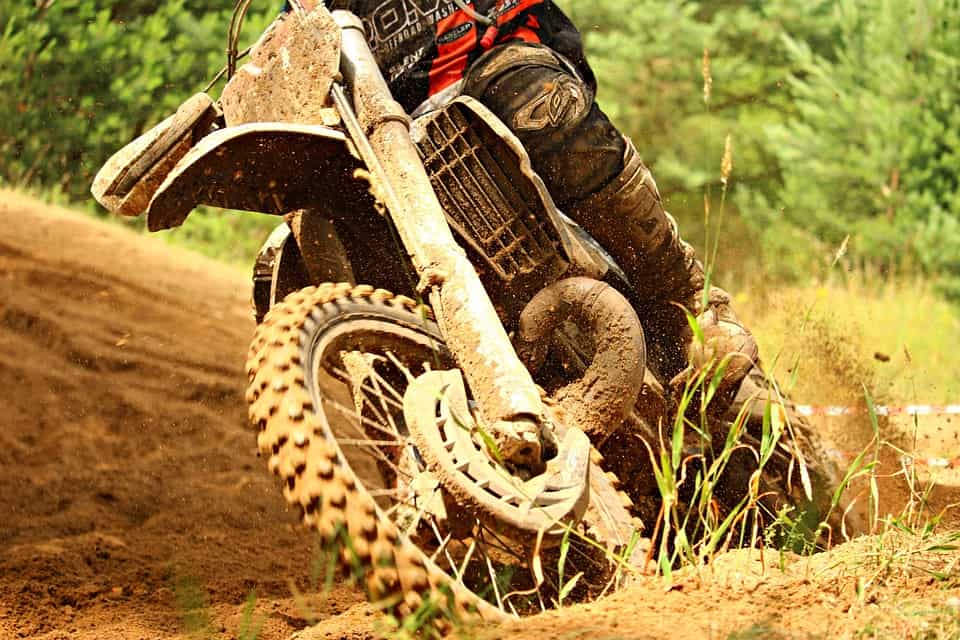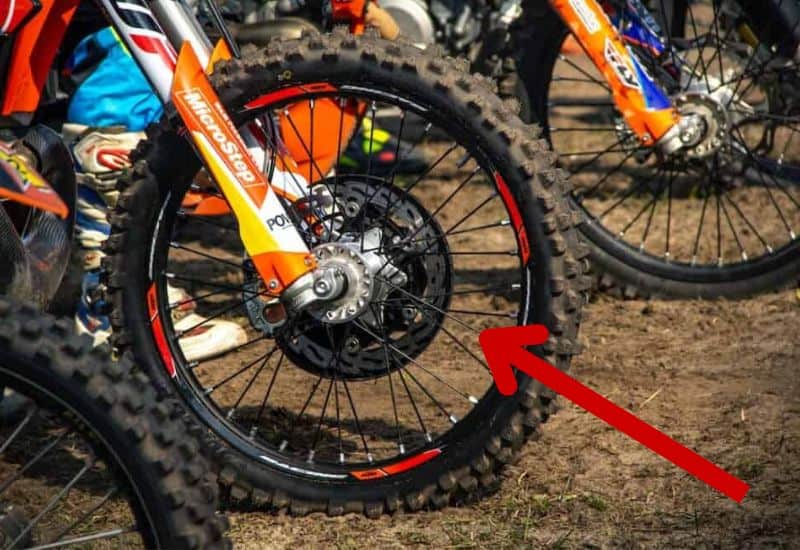Dirt bikes are instantly recognizable for their knobby, rugged tires and spoked wheels, which look very different from the wheels you’d see on a street bike or cruiser.
But this iconic spoked wheel design isn’t just for looks – it serves key functional purposes that make it the best match for handling off-road riding conditions.
In this blog post, we’ll uncover why spoked wheels offer unique advantages that have made them the standard for dirt bikes.
We’ll look at how they provide critical shock absorption, flex to compensate for dips and bumps, and durability to withstand harsh riding environments.
Key Takeaways
- Spoked wheels handle the impacts and irregular terrain better than solid-cast wheels.
- The spokes act like shock absorbers and conform to obstacles, whereas solid wheels dent and bend.
- The flexibility of spoked wheels enables them to absorb harsh bumps and landing impacts that would permanently warp other wheel types.
- While spoked wheels require a bit more maintenance and can occasionally break, for normal dirt bike riding they are the best option.
What Are Spoked Wheels?
Before examining why spoke wheels are ideal for dirt bikes, let’s quickly go over what spoked wheel construction looks like.
Spoked wheels feature a central hub that the axle runs through, composed of an alloy like aluminum or steel.
This hub anchors thin spokes made of materials like steel that radiate outwards and connect to the outer rim where the tire mounts.
Key Components of a Spoked Wheel:
- Hub – Central Part that Attaches to Axle
- Spokes – Thin Rods that Connect the Hub to the Rim
- Rim – Outer Edge of Wheel Where Tire Mounts
This creates a web-type structure that makes the wheels far lighter compared to cast aluminum or even magnesium wheels, which utilize a single form from the hub to the outer rim.
But beyond their lightness, the most important aspects are the flexibility and shock absorption the spokes provide.
Why Are Spoked Wheels Used on Dirt Bikes?
So why does the spoked wheel design dominate dirt bikes instead of other options?
Let’s look at how they specifically address the demands of dirt biking.
Dirt bikes face extremely demanding conditions racing over bumpy, uneven terrain with obstacles, holes, ruts, and jumps stressing the bike’s components.
Because of this, solid one-piece wheels would get bent out of shape and damaged very quickly.
That’s why flexible, shock-absorbing spoked wheels are ideal for these conditions.
Key advantages of spoked wheels on dirt bikes:
- Absorb impacts from bumps and jumps without damage.
- Spokes flex to compensate for dips and holes on rough terrain.
- Cast aluminum wheels can’t flex – they bend and dent.
- The lightweight design makes the bike easier to control in the air after jumps.
- Reduces rider fatigue compared to heavier wheels.
- Helps to grip loose dirt and muddy conditions better than solid wheels.
In short, spoked wheels handle abuse, flex rather than bend, cushion landings, reduce rider fatigue, and maintain control in the air.
No other wheel can match this overall combo!
Shock Absorption & Impact Resistance Capabilities
The main reason why dirt bikes use spoked wheels comes down to their unmatched ability to absorb shocks from the trail and withstand harsh impacts on landings.
So let’s take a closer look at how spoked wheels can do this.
- Shock Absorption – As a dirt bike hits ruts, holes, or other obstacles on the trail, the spokes flex to cushion the impact. They act like tiny shock absorbers to dampen the force instead of directly transferring it to the body of the bike. This protects components like the fork, swingarm, and engine mounts. Plus, it also helps the rider maintain control.
- Impact Resistance – Spoked wheels handle big impacts far better than solid wheels. On harsh landings from jumps, they can flex significantly to dissipate force without getting bent out of shape. The same hard landing would easily warp a cast aluminum wheel.
- Flexibility – The spokes can bend quite a bit to conform to holes, dips, and irregularities on the trail and then return to their original shape rather than forcing the entire wheel to deform. This allows them to compensate for a wide range of terrain variations.
- Light Weight – This goes hand in hand with impact resistance because minimizing the wheel’s weight reduces the force applied to bike components on landings. Lighter wheels also translate to better suspension control and handling.
So in bumpy, jagged riding conditions, the spokes act almost like a rubberband – stretching and compressing to compensate for radical terrain changes and then bouncing back without permanent damage.
Summing Up Spoked Wheel Advantages For Dirt Bikes
To summarize so far, spoked wheels are the best option for dirt bikes for all the reasons below:
- Shock Absorption – Critical for handling bumpy, uneven terrain without rattling the bike and rider or damaging components.
- Impact Resistance – Vital for surviving hard landings from jumps/drops without bending or denting the wheel.
- Flexibility – Allows wheels to give over obstacles and then return to shape rather than deform.
- Light Weight – Reduces the force of landings and improves overall bike handling.
This combination makes spoked wheels essentially unbeatable for managing the abuse that dirt bike riding dishes out.
No other wheel design comes close to the durability, control, and bump compensation provided.
With that being said though, spoked wheels are not perfect, as they do have some disadvantages.
Drawbacks & Compromises of Spoked Wheels

The main downside of spoked wheels versus solid cast wheel alternatives comes down to maintenance requirements and durability on the extreme end.
As spoked wheels do have the following drawbacks:
- Prone to broken spokes from severe impacts past their flex limit.
- Spokes require more vigilant inspection and maintenance to spot damage.
- At extreme levels, solid wheels can be slightly more durable in certain circumstances.
For example, solid one-piece wheels may have a bit of an advantage in the most abusive forms of downhill or freestyle riding with repetitive six-foot-plus jumps placing incredible strain on components.
In those cases, spokes can occasionally fail or require replacement whereas solid wheels may warp but ultimately withstand more long-term abuse.
But for the vast majority of recreational and racing dirt bike users, the benefits of spokes heavily outweigh the drawbacks.
Plus, in reality, maintenance on spoked wheels is fairly minimal, and occasionally inspections are just fine, a good rule of thumb is every time you wash the bike.
Frequently Asked Questions
Spoked wheels are better for off-road riding because of their ability to flex and compress, which acts as a shock absorber over rough terrain. As the bike encounters bumps, holes, and other obstacles on unpaved surfaces, the spokes bend and stretch to dampen the impacts before they reach the bike frame and rider. This protects components from damage and helps the rider maintain control.
The strongest spoke pattern for a spoked wheel is when the spokes are laced in a crossing, interlaced pattern from hub to rim. This crisscross design means each spoke supports multiple other spokes in a distribution of tension across the whole wheel. The most common strong lacing pattern is the 3-cross pattern. On these, each spoke crosses 3 other spokes between the hub and the rim. This creates a tightly interwoven lattice with redundancy, so that even if one spoke fails, the surrounding ones redistribute tension.
Spokes are made of steel because they combine high tensile strength with moderate flexibility to handle shocks and deformation. Compared to alternate metals like titanium or aluminum, steel achieves the best balance of durability and elastic response. Titanium is stronger but stiffer while aluminum is more flexible but less resilient to extreme force.
Spoked Wheel Wrap-Up
Spoked wheels were used on some of the earliest motorcycles dating back more than 100 years, and they still endure today as the standard on dirt bikes, because no alternative can handle the unique demands riders subject them to.
Purpose-built to absorb abuse, resist impacts, conform to various terrains, and provide long-term durability, they offer unmatched performance.
Where other wheel types dent, deform, and fail under these conditions, the spoked wheel’s flexibility protects the bike and rider while enabling precise handling when it matters most.
This is why, you’ll only find knobby tires wrapped around lightweight spoked wheels in the backcountry and on the track.
So next time you watch a dirt biker launching through the air and sticking the landing with ease, take a closer look at those iconic spoked wheels making it all possible!

